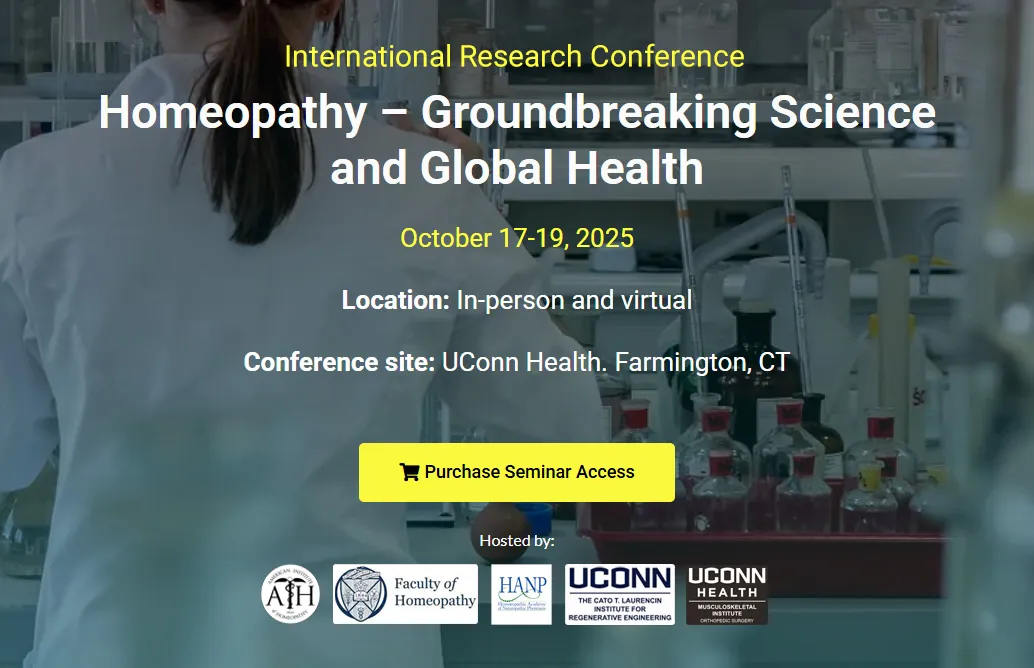American Journal of Homeopathic Medicine

AJHM – Autumn 2020
Volume 113 Number 3
Table of Contents
- President’s Message: Important News
- Editorial: Epidemic Concerns
- In Memoriam: Jacquelyn Wilson, MD, DHt
- Homeopathic PuZZle?
- In the News
- Editorial: Homoeopathy Stonewalled
- Diversity 101 for Homeopaths
- The Tragedy of Epidemic Diseases and Homoeopathy, with Some Reflections on Genius Epidemicus and Covid-19: Part I
- Historical Mortality Statistics in Cholera and Yellow Fever
- ‘Working ‘ a Case of Mononucleosis
- Severe Case of Presumed Covid-19
- Homeopathy and Immune Boosting: Research Review and Discussion of Possible Mechanism of Action
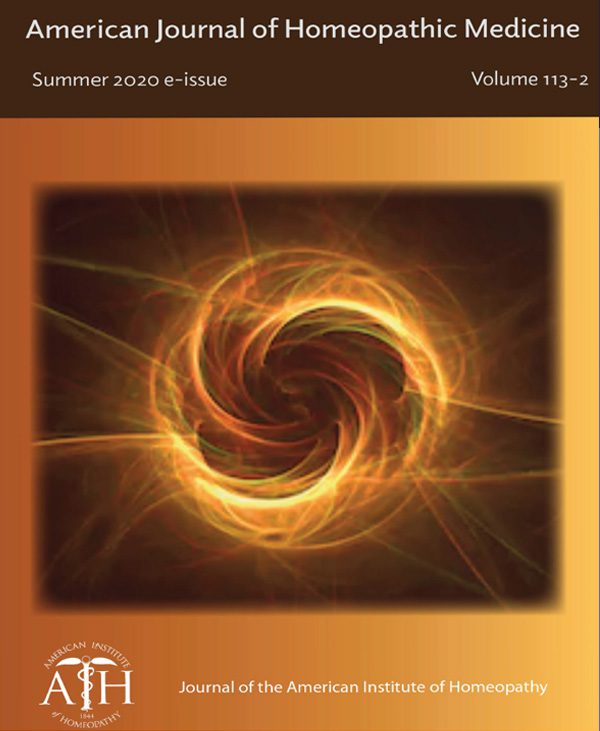
AJHM – Summer 2020
Volume 113 Number 2
Table of Contents
- President’s Message: AIH News
- Editorial: Treating Corona Virus Patients
- In the News
- In Memoriam: Tony Bark, MD
- The Unscientific, Fear-Based War against the Microbiome
- COVID-19: A Review of Preliminary Clinical and Pathologic Findings
- Two Cases of a Flu-like Syndrome During the COVID-19 Pandemic
- Suspected Case of Covid-19 in a 64-Year-Old Woman
- Organon: Hahnemann’s Approach to Epidemics
- Homeopathy Was His Mission: Royal Copeland, MD
- Editorial on Dr. Rutten’s Article: Statistics and Homeopathy
- Experience and Science: Bayes’ Theorem
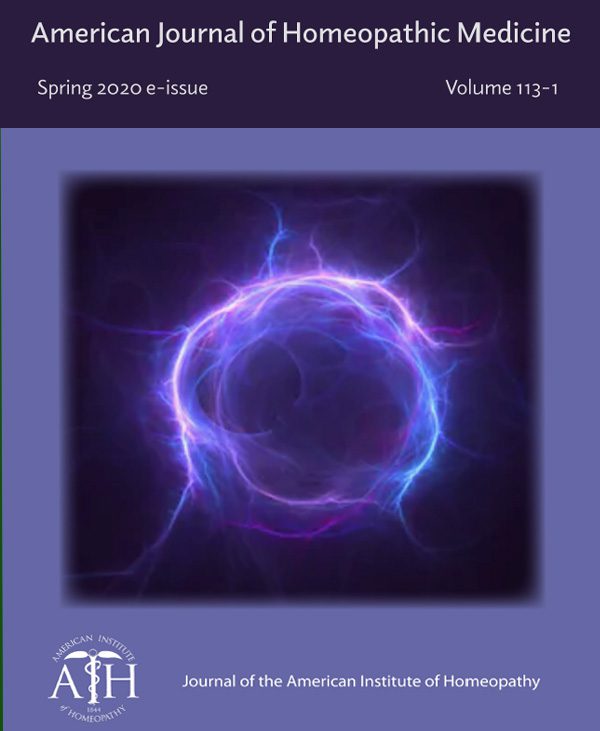
AJHM – Spring 2020
Volume 113 Number 1
Table of Contents
- President’s Message: AIH News
- Editorial
- Of Some Interest & In the News
- AIH Records at Drexel University
- Homeopathic PuZZle?
- Obituary: Sheilagh Creasy
- Interpreting Hahnemann’s Changing Use of Drugs
- Organon: Translation and Comments on Aphorism 1a
- Homeopathic Treatment of Long-Standing Psoriasis
- A Case of Carcinoma of the Breast Vs Erysipleas and Arsenicum
- 74th Sorento, Italy Liga Conference Report
- Homeopathy and Infections: A Brief Review of Articles
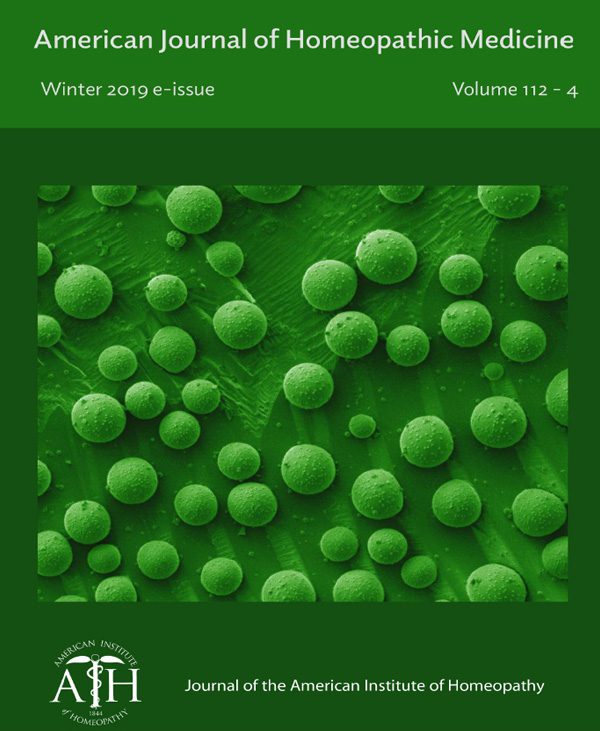
AJHM – Winter 2019
Volume 112 Number 4
Table of Contents
- President’s Message: Important News
- Editorial: Toward the Pursuit of Truth
- Of Some Interest
- Tremendous LMHI Conference in Sorento!
- Texas Society of Homeopathy 28th Annual Conference
- The Great Australian Cover-Up: How NHMRC Abused Public Trust and Caused Worldwide Repercussions for Homeopathy
- Organon: Ʃ of Correct Remedy Qualities
- A Retrospective Study of the Efficacy of Homeopathic Treatment on Patients with Substance Abuse Disorder Attending Primary Health Centers
- A Case of Cardiac Dysrhythmia
- Dying from Stress: A Case of Takotsubo Cardiomyopathy and Autoimmune Hepatitis Treated Homeopathically
- A New High Quality Study of Individualized Homeopathy in Bronchial Asthma
- Mapping the Cancer Journey: 2019 AIH Conference
Abstracts
Ʃ of Correct Remedy Qualities Joel Shepperd, MD
Introduction: When medicinal substances initiate the curing and healing process, the Law of Similars is the unifying principle of this homeopathic method. The Organon mentions several more essential qualities of medicines in order for the correct remedy to work well in actual practice.
Keywords: single, simple, salutary, smallest, subtle, spirit-like, stronger specificum, similar symptoms
A Retrospective Study of the Efficacy of Homeopathic Treatment on Patients with Substance Abuse Disorder Attending Primary Health Centers
Gyandas G Wadhwani, MD (Hom) , Yumna Ebrahim, M.Tech Hom
Abstract: Background: Substance abuse disorder is a medical condition whereby the use of one or more psychoactive drugs leads to a clinically significant impairment or distress to the individual’s physical, mental and social health. Aim: To evaluate retrospectively the effects of Homeopathic treatment on patients who consulted us in primary health centres primarily for, or were found during clinical evaluation to be suffering from, substance abuse disorder. Material and method: The records of thirteen patients suffering from substance abuse disorder who consulted us between September 1999 and March 2019 were evaluated retrospectively. They had received individualized classical Homeopathic treatment based on their symptom picture and were followed for a period ranging between 6 months and 8 years. Results: 92.31% responded to the individualized Homeopathic treatment; 69.24% of patients showed a sustained remission; 15.38% relapsed after staying sober for more than two years; 7.69% relapsed after 3 months and died; 7.69% dropped out, citing slow response.
Conclusion: Homeopathic treatment produced significant improvement in QoL with substance abuse disorder through individualized classical prescribing. Further exploratory research studies may be taken up to ascertain the role of homeopathy in these disorders.
Keywords: substance abuse disorder, homoeopathy, individualization, retrospective study

AJHM – Autumn 2019
Volume 112 Number 3
Table of Contents
- President’s Message: Important Upcoming Events
- Editorial: Broadening Homeopathy’s Appeal
- Guest Editorial: What Should We Talk About?
- Of Some Interest
- In the News
- Obituary: Prof. Dr. Eugenio Candegabe
- In Memoriam: Phillip Bonnett, MD
- Organon: Types in Homeopathy
- Echinacea angustifolia: Small Remedy, Huge Action
- Mancinella, Past and Present: A Case and Comparative Perspectives
- Homeopathic Treatment of Anemia in Adolescent Girls
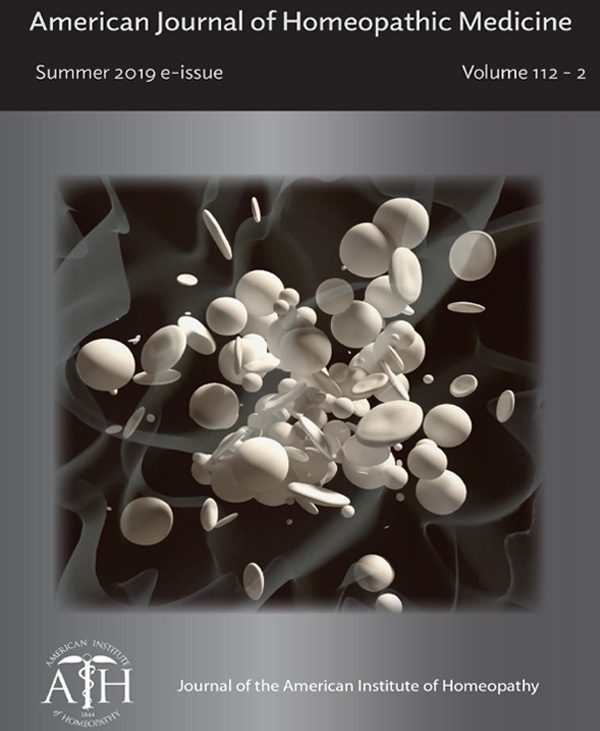
AJHM – Summer 2019
Volume 112 Number 2
Table of Contents
- President’s Message: An Eventful Time
- Editorial: Learning Together
- Guest Editorial: Does Anyone Need the AIH?
- In the News
- Feature Article: Grand Map of Curative Medicine §1- §6
- Summary of Kali muriaticum for the Materia Medica Pura Project
- An Acute Case of Gingivitis: The Importance of Taking a Complete Case
- Report from the Trenches: Chronic Lyme Disease, etc
- Individualized Homeopathy Reduces Symptoms of Chronic Chikungunya in Haiti: A Pilot Data-Collection Project
- Book Review: How to End the Autism Epidemic by J.B. Handley
Abstracts
Feature Article: Grand Map of Curative Medicine §1- §6 Joel Shepperd, MD
Abstract: In Aphorisms one to six of the Organon, Hahnemann describes the framework that enables a doctor to cure the sick: The doctor must act from intelligible principles. He must know what to cure and how to cure with medicinal substances. He must practice preventive medicine. He must know the subjective and objective manifestations of the totality of disease. He must know that the cause of dynamic disease is nonmaterial.
Keywords: cure, intelligible principles, a call to action, obstacles to cure, gestalt, nonmaterial cause.
Summary of Kali muriaticum for the Materia Medica Pura Project Tim Fior, MD, DHt
Abstract: This is an extract of a monograph on Kali muriaticum prepared for the Materia Medica Pura Project (MMPP). This is an abridged version with a description and summary of the remedy and a few cases. The remedy is characterized by whiteness of discharges and eruptions and a concomitant of a white coating on the tongue. It is useful for the second stage of fevers and inflammation when there are white exudates and swelling. It is a slow-acting remedy that is useful for eustachian catarrh and many eye conditions, and the first stages of breast cancer with a soft, doughy lump. It is worse with fat or rich foods. It has been generally under-utilized.
Keywords: Kali muriaticum, Kali chloricum, Materia Medica Pura Project, breech presentation with complications, repertory additions, white exudates, eustachian catarrh, eye condition; breast cancer, early stage of
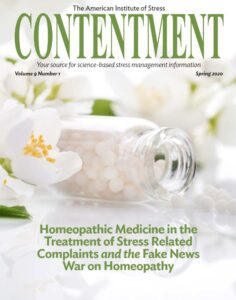 In 2020, the Editor in Chief of AJHM was the Guest Editor for:
In 2020, the Editor in Chief of AJHM was the Guest Editor for:
The American Institute of Stress’ Contentment Magazine
Volume 9 Number 1; Spring 2020 issue
Homeopathic Medicine in the Treatment of Stress Related Complaints and the Fake News War on Homeopathy
Alex Bekker, MD, ABIHM, FAIS
The American Journal of Homeopathic Medicine (AJHM) is a peer-reviewed scientific journal, specifically intended to meet the needs of physicians involved in the specialty of homeopathy. The editor invites original manuscripts, feature articles, research reports, ‘Homeopathic Grand Rounds’ cases studies, abbreviated case reports for ‘Clinical Snapshots,’ seminar reports, and position papers that focus on homeopathy, as well as book reviews and letters to the editor.
Submit articles via email to Alex Bekker, MD, at alexbekker@alexbekkermd.com.


